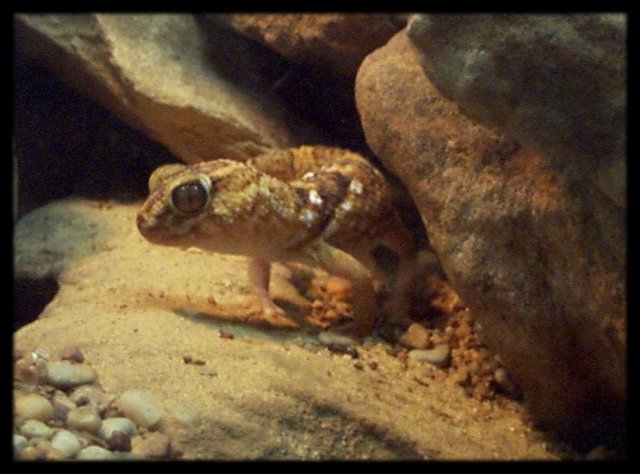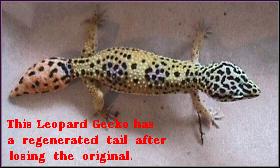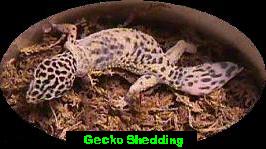

General Information on Geckos:
Geckos form a large
family of Lizard best known for their nocturnal way of life and the ease
with which some species run up walls. The typical gecko has a flattened
head and a body with soft skin, containing many minute scales. Most
are nocturnal animals and have enormous eyes, each with a permanently
closed transparent eyelid. Many have "friction pads" of specialized
scales under the toes, which enable them to climb easily up vertical surfaces
and even to walk upside down, on a ceiling for instance.
 |
 |
|
| Name: Leopard Gecko |
| Scientific Name: Eublepharis macularius (Eublepharis: meaning real or true eyelids and Macularius meaning spotted) |
| Range: Found in Iran, Afghanistan, Western India, and Pakistan. |
| Habitat: Reside in deserts and arid grasslands. |
| Status: Not Endangered |
| Diet: Crickets, meal worms, and pinkie mice. All foods must be no longer than half the width of Its head. |
| Supplements: Food should be supplemented with calcium and multivitamins. |
| Location in the Zoo: Herpetarium |
| Physical description:Leopard Geckos reach a size of 8 to 10 inches. Some leopards have grown to 12 inches. Most adults are yellow with dark brown spots. The tail is banded white and light black, they are white on bottom. Young geckos are generally banded yellow and dark brown which fades into the spotted pattern as the gecko matures. |
| General
information:
Sex: The
male geckos seem to have a broader head and neck than the female and the
bodies are somewhat larger.
|
| Special
anatomical, physiological or behavioral adaptations:
Unlike most geckos, which have fused transparent eyelids, this species is one of the few with movable eyelids (a primitive characteristic in the gecko family). Its legs are long and thin and it holds its body well off the ground when it runs. Shedding: Leopard geckos skin does not come off in bits and pieces, they bite on to their skin and eat it to get vitamins from it, so there is not any skin left behind after shedding. |

| Comments
about the geckos of the Fort Worth Zoo:
I didn't exactly get a chance to speak to a specific gecko keeper, but I did speak to a zoo personnel. The did inform me that there is not much trouble in caring for these geckos compared to the other animals at the zoo. "They are active creatures that love to run around." But due to the fact that there is not much space provided for these geckos, they are kept in a small tank. |
| Personal
Observations:
The leopard gecko or just geckos in general amaze me. I myself had a gecko but he did not last to long. After doing my research, I know now what I did and didn't do correctly. I feel that I got a lot accomplished in my research. |
| This
page was done by: Maria Martinez
E-mail: angelsmm@hotmail.com |
WhoZoo Home |
| Source of information:
Fort Worth Zoo |